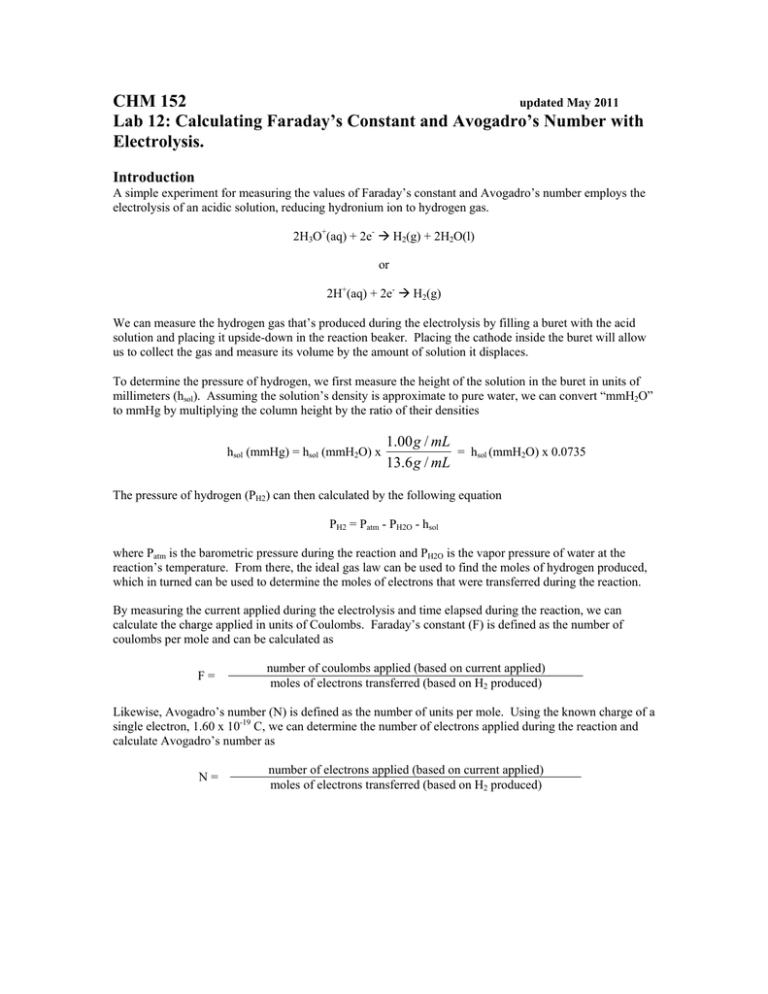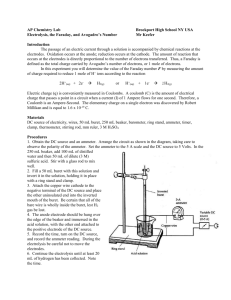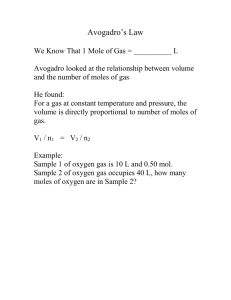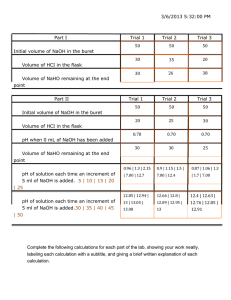CHM 152 Lab 12: Calculating Faraday’s Constant and Avogadro’s Number with
advertisement

CHM 152 updated May 2011 Lab 12: Calculating Faraday’s Constant and Avogadro’s Number with Electrolysis. Introduction A simple experiment for measuring the values of Faraday’s constant and Avogadro’s number employs the electrolysis of an acidic solution, reducing hydronium ion to hydrogen gas. 2H3O+(aq) + 2e- Æ H2(g) + 2H2O(l) or 2H+(aq) + 2e- Æ H2(g) We can measure the hydrogen gas that’s produced during the electrolysis by filling a buret with the acid solution and placing it upside-down in the reaction beaker. Placing the cathode inside the buret will allow us to collect the gas and measure its volume by the amount of solution it displaces. To determine the pressure of hydrogen, we first measure the height of the solution in the buret in units of millimeters (hsol). Assuming the solution’s density is approximate to pure water, we can convert “mmH2O” to mmHg by multiplying the column height by the ratio of their densities hsol (mmHg) = hsol (mmH2O) x 1.00 g / mL = hsol (mmH2O) x 0.0735 13.6 g / mL The pressure of hydrogen (PH2) can then calculated by the following equation PH2 = Patm - PH2O - hsol where Patm is the barometric pressure during the reaction and PH2O is the vapor pressure of water at the reaction’s temperature. From there, the ideal gas law can be used to find the moles of hydrogen produced, which in turned can be used to determine the moles of electrons that were transferred during the reaction. By measuring the current applied during the electrolysis and time elapsed during the reaction, we can calculate the charge applied in units of Coulombs. Faraday’s constant (F) is defined as the number of coulombs per mole and can be calculated as F= number of coulombs applied (based on current applied) moles of electrons transferred (based on H2 produced) Likewise, Avogadro’s number (N) is defined as the number of units per mole. Using the known charge of a single electron, 1.60 x 10-19 C, we can determine the number of electrons applied during the reaction and calculate Avogadro’s number as N= number of electrons applied (based on current applied) moles of electrons transferred (based on H2 produced) Concepts to Review • • • • Oxidation-reduction reactions Electrolysis Ideal gas law Calculations with amperes Procedure 1. Obtain a power supply and two cables that have alligator clips at one end. Also obtain two small pieces of insulated wire (approximately six inches, with a small amount of exposed wire at each end). 2. Completely Fill a 50 mL buret with 1 M sulfuric acid (to the top, not 0 mL). 3. Add 150 mL of 1 M sulfuric acid to a medium-sized beaker (250-400 mL). 4. Take a piece of insulated wire and insert one end in the buret (about 1-2 inches). Place a finger over the buret opening, holding the wire in place, then carefully invert the buret and set it into the solution in the beaker. Use a ring stand and clamp to hold the buret in place. [Note: the sulfuric acid you’re using is about the same concentration as household vinegar. Your finger will be fine; just rinse it off after completing this step] 5. Clip the other end of the insulated wire to the cable attached to the negative end of your power supply (keep the alligator clip out of the solution). This will serve as the cathode. 6. Take the other insulated wire and clip one end to the cable attached to the positive end of your power supply. Place the other end of the wire in the beaker. This will serve as the anode. 7. Turn on the power supply and adjust the voltage until hydrogen bubbles form in solution. Allow the reaction to continue until solution level in the buret is below the 50 mL line then turn off the power. 8. Record the initial volume of the solution and turn on the power, noting the starting time of the reaction as well as the initial current being applied. Record the current in 5 mL intervals. 9. Turn off the power once 25 mL of hydrogen has been collected, noting the final volume of the solution. 10. Using a meter stick, measure the height of the solution remaining in the buret, starting from the surface of the solution in the beaker (not the buret opening). 11. Repeat this experiment two more times for a total of three trials. [Note: the exposed wire can dissolve in the acidic solution over time. After each trial, check your wire and use a razor or scissors to expose more wire, if needed. Replace the solution in the beaker if it’s turned blue.] Waste disposal Sulfuric acid solutions can be poured down the drain with running water. Vapor pressure of water T (ºC) 20 21 22 23 24 PH20 (mmHg) 17.5 18.7 19.8 21.1 22.4 T (ºC) 25 26 27 28 29 PH20 (mmHg) 23.8 25.2 26.7 28.3 30.0 Name __________________________________ Data Trial 1 Trial 2 Trial 3 1. Starting time of reaction ________ ________ ________ 2. Ending time of reaction ________ ________ ________ 3. Reaction time (s) ________ ________ ________ 4. Initial buret volume (mL) ________ ________ ________ 5. Final buret volume (mL) ________ ________ ________ 6. Initial current (A) ________ ________ ________ after 5 mL ________ ________ ________ after 10 mL ________ ________ ________ after 15 mL ________ ________ ________ after 20 mL ________ ________ ________ after 25 mL ________ ________ ________ 7. Volume of H2 produced (mL) ________ ________ ________ 8. Solution temperature (°C) ________ ________ ________ 9. Solution temperature (K) ________ ________ ________ 10. Column height (mm) ________ ________ ________ 11. Column height (mmHg) ________ ________ ________ 11. Barometric pressure (mmHg) ________ ________ ________ 12. Vapor pressure of water at reaction temperature (mmHg) ________ ________ ________ 10. Pressure of H2 (mmHg) ________ ________ ________ 11. Pressure of H2 (atm) ________ ________ ________ 12. Moles of H2 produced ________ ________ ________ 13. Moles of electrons transferred (based on H2 produced) ________ ________ ________ 14. Average current applied (A) ________ ________ ________ 15. Coulombs applied ________ ________ ________ 17. Experimental value of Faraday’s constant ________ ________ ________ Average ____________ 18. Actual value of Faraday’s const. ____________ 19. Percent error ____________ 20. Total electrons applied (based on coulombs applied) ________ ________ ________ 21. Experimental value of Avogadro’s number ________ ________ ________ Average ____________ 22. Actual value of Avogadro’s no. ____________ 23. Percent error ____________ Percent Error = Exp-Actual Acutal x 100 Show your work for each of the following calculations from Trial 1 a) Partial pressure of hydrogen b) Moles of hydrogen produced c) Moles of electrons transferred (based on H2 produced) d) Coulombs applied e) Total electrons applied (based on coulombs applied) f) Faraday’s constant g) Avogadro’s number Name: _____________________________ Section: ________ Post-lab Questions 1. How would each of the follow errors affect your calculated value of Avogadro’s number (incorrectly high, low, or no effect)? Explain your answers. a) The vapor pressure of water wasn’t factored into your calculations. b) Part of the cathode was sticking out of the buret opening c) 1.5 M sulfuric acid was used instead of 1 M. d) The column height was not converted to units of mmHg 2. When measuring Avogadro’s and Faraday’s numbers by this method, what assumption is being made regarding the current being applied (other than the amperage remaining constant)? 3. This experiment could also be performed using a chloride solution instead of an acid. 2Cl-(aq) Æ Cl2(g) + 2eWhat modifications, if any, would need to be done to the procedure if this substitution was made? Name: _____________________________ Section: ________ Pre-lab Questions 1. Define the following terms. a) Coulombs b) Amperes 2. Explain the importance of each the following for this experiment. a) Using deionized water to prepare the sulfuric acid solutions. b) Making sure the exposed part of the insulated wire is fully inserted in the buret in step 4. 3. How many electrons are transferred by a 0.433 A current running for 13 minutes? 4. How many moles of electrons are required to produce 43 mL of 752 mmHg hydrogen gas at 21 °C? 5. The solution will sometimes turn blue during electrolysis. Based on your previous lab experience, what ion is probably causing this? Could the presence of this ion interfere with the reaction being studied? Why or why not?







